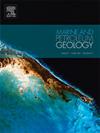成岩和层序地层对美国阿肯色州南部上侏罗统Smackover组储层质量的控制
IF 3.6
2区 地球科学
Q1 GEOSCIENCES, MULTIDISCIPLINARY
引用次数: 0
摘要
美国墨西哥湾地区的上侏罗统Smackover地层是一个成熟的油气层,近几十年来,它已成为生产富锂盐水的目标,也是一个潜在的碳储存场所。尽管如此,Smackover组的层序地层格架仍存在广泛的争议。了解成岩作用时空控制的最具挑战性的方面之一是建立层序地层格架。这些不确定性导致了描述孔隙度和渗透率趋势的不确定性。在此基础上,研究了Smackover组储层物性特征,建立了层序地层格架,确定了Smackover组沉积与成岩作用的时空关系。本研究利用了来自阿肯色州南部Smackover地层的12个地下岩心,主要包括Smackover“B”[上侏罗统(UJ) III层序],以及较小程度的Smackover“C”(UJ II层序)。通过对比215口测井资料,评估了Smackover“B”和“C”的三维地层格架。从南北走向的二维地震剖面来看,Smackover“B”被解释为由一系列沉积在阿肯色州南部低角度Smackover“C”斜坡上的进积准层序组成。基于对数相关分析,我们将Smackover“B”型进积准层序解释为:沿内斜坡顶置层倾角为0.25°,沿中斜坡前置层倾角为0.5°~ 1.0°,沿外斜坡底置层倾角为0.25°。基于这些几何图形,在Smackover“B”内进行了25个准层序的对比。Smackover“B”和其上的Buckner组具有7种不同的沉积相,反映了从海岸沙丘间盐碱地或sabkhas到浅海中外侧斜坡的沉积剖面。Smackover“B”被解释为反映了一个浅层的上升趋势,由鲕粒-鲕粒砾岩覆盖的鲕粒-鲕粒砾岩,覆盖的是Buckner组粉质白云质泥岩和泥质结节硬石膏。下面的Smackover“C”主要由岩屑-砾石组成。总体而言,Smackover“B”和“C”经历了不同程度和类型的成岩作用,包括胶结作用、溶蚀作用和白云石化作用。在成岩蚀变沉积相分类的基础上,确定了16个成岩相。Smackover“B”由薄边缘胶结的流体层、紧密的完全胶结的流体层、模塑流体层和球型颗粒岩层交替组成。Smackover“B”的胶结和溶解的样式和程度的垂直模式被解释为反映了UJ III层序内低振幅、高频相对海平面变化驱动的大气渗透带、大气潜水带和海洋潜水带之间的振荡。在ujiii层序边界下,Smackover“C”/ ujii高地最上端为白云化程度不断增加的上行剖面。Smackover“C”白云岩被认为是在UJ III低洼期形成的。Smackover组成岩作用程度和风格的时空变化被解释为受相对海平面变化的驱动。该研究展示了相对海平面之间的相互作用如何驱动成岩流体的演化,从而显著影响阿肯色州南部Smackover组“B”和“C”的储层质量。本文章由计算机程序翻译,如有差异,请以英文原文为准。
Diagenetic and sequence stratigraphic controls on reservoir quality in the Upper Jurassic Smackover Formation, southern Arkansas, USA
The Upper Jurassic Smackover Formation of the U.S. Gulf Coast Region is a mature hydrocarbon play that, in recent decades, has become a target for producing lithium-rich brines and a potential site for carbon storage. Despite this activity, the sequence stratigraphic framework of the Smackover Formation is widely disputed. One of the most challenging aspects of understanding the spatial and temporal controls on diagenesis is establishing the sequence stratigraphic framework. These uncertainties have resulted in uncertainty in delineating trends in porosity and permeability. Here, we characterize the reservoir quality, establish the sequence stratigraphic framework, and determine the spatio-temporal relationship between depositional and diagenetic processes in the Smackover Formation.
This study utilizes twelve subsurface cores from the Smackover Formation across southern Arkansas, including predominantly the Smackover “B” [Upper Jurassic (UJ) III Sequence] and, to a lesser degree, the Smackover “C” (UJ II Sequence). 215 well logs were correlated to assess the 3-D stratigraphic framework of the Smackover “B” and “C”. From a north-south oriented 2D seismic profile, the Smackover “B” is interpreted to consist of a series of progradational parasequences deposited over the lower-angle Smackover “C” ramp in southern Arkansas. Based on log-correlations, we interpret the Smackover “B” progradational parasequences to have top-set beds with a dip of 0.25° along the inner ramp, foreset beds with a dip of 0.5°–1.0° along the mid ramp, and bottomset beds with a dip of 0.25° along the outer ramp in this area. Based on these geometries, twenty-five parasequences were correlated within the Smackover “B”. The Smackover "B” and overlying Buckner Formation is characterized by seven different depositional facies interpreted to reflect a depositional profile that extends from coastal interdune salinas or sabkhas to a shallow marine mid-outer ramp setting. The Smackover “B” is interpreted to reflect a shallowing upward trend consisting of peloidal wacke-to-packstone overlain by ooid-oncoid grainstone, capped by silty dolomitic mudstone and shaley nodular anhydrite of the Buckner Formation. The underlying Smackover “C” consists predominantly of peloidal wacke-to-packstone. In general, the Smackover “B” and “C” have undergone varying degrees and styles of diagenesis, including cementation, dissolution, and dolomitization. Based on the classification of diagenetically altered depositional facies, sixteen diagenetic facies were identified. The Smackover “B” consists of alternating beds of thin-rim cemented ooid, tight fully cemented ooid, moldic ooid, and peloidal grainstones. Vertical patterns in the styles and degree of cementation and dissolution in the Smackover “B” is interpreted to reflect oscillations between the meteoric vadose, meteoric phreatic, and marine phreatic zones driven by low amplitude, high-frequency relative sea level changes within the UJ III sequence. Underlying the UJ III sequence boundary, the uppermost part of Smackover “C”/UJ II highstand is characterized by an increasing degree of dolomitization up section. The Smackover “C” dolomite are interpreted to have formed subsequently during the UJ III lowstand. This spatial and temporal variability in the degree and style of diagenesis in the Smackover Formation is interpreted to be driven by changes in relative sea level. This study demonstrates how the interplay between relative sea level drives the evolution of diagenetic fluids which in turn significantly impact reservoir quality in the Smackover Formation “B” and “C” in southern Arkansas.
求助全文
通过发布文献求助,成功后即可免费获取论文全文。
去求助
来源期刊

Marine and Petroleum Geology
地学-地球科学综合
CiteScore
8.80
自引率
14.30%
发文量
475
审稿时长
63 days
期刊介绍:
Marine and Petroleum Geology is the pre-eminent international forum for the exchange of multidisciplinary concepts, interpretations and techniques for all concerned with marine and petroleum geology in industry, government and academia. Rapid bimonthly publication allows early communications of papers or short communications to the geoscience community.
Marine and Petroleum Geology is essential reading for geologists, geophysicists and explorationists in industry, government and academia working in the following areas: marine geology; basin analysis and evaluation; organic geochemistry; reserve/resource estimation; seismic stratigraphy; thermal models of basic evolution; sedimentary geology; continental margins; geophysical interpretation; structural geology/tectonics; formation evaluation techniques; well logging.
 求助内容:
求助内容: 应助结果提醒方式:
应助结果提醒方式:


